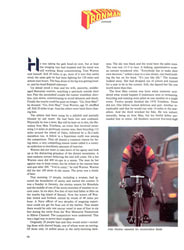
IF JOGGING IS TOO MINDLESS AND CHESS TOO SEDENTARY, TRY JOGGER'S CHESS
Einer Jensen contemplated the next move. A venturesome knight was threatening his king's rook, while his queen's bishop was in jeopardy at the hands of an upstart pawn. He decided to save the rook.
Jensen paused, squared his shoulders and scrunched down his horned Viking helmet. Swinging his arms in frenzied semicircles, he scurried backward like a startled crab onto the 256-square-foot chess "board" he had set up with agricultural lime in a meadow in San Francisco's Golden Gate Park. Jensen then grabbed the two-foot-high rook and carried it to safely four squares away. Then he hopped off the board and stopped the clock, a four-foot-high wooden timer resembling a coatrack with oversized ears.
Jensen, a 49-year-old Danish-born restaurateur, was showing off his moves in a phenomenon of his own invention known as Jogger's Chess. Dissatisfied with what he considered the non-intellectual nature of jogging, Jensen retired to the garage behind his restaurant a few months ago and set about creating a pastime that he believed would improve the mind as well as the body. Five days later he emerged with a giant chess set consisting of plywood pieces up to two feet tall, each weighing five pounds.
Jogger's Chess combines the brainwork of regular chess with some of the rigors of running. Because games are limited to 20 minutes, one needs more speed than endurance to compete. In a typical 50-move game, a player runs the equivalent of an all-out half mile. Sedentary types, used to the luxury of pondering for hours, find themselves out of breath long before they are out of moves.
The scoring system is slightly eccentric. Each player is given 50 points at the beginning of the game. As play progresses, the "Official Scorer" awards plus points for outstanding exercises (high knee lifts, somersaults, jumping jacks, etc.) and minus points for sloppy play, lack of imagination and knocking over pieces. Points are also awarded for each move. A player who checkmates his opponent gets 25 points. However, when the plus and minus points are added up at the end of a game, a klutz might find he has won at chess but lost at Jogger's Chess because his opponent has performed dazzling footwork and fanciful routines—like somersaulting onto the board to move a piece, then crawling off on all fours.
At Golden Gate Park one recent Sunday morning, the most exciting match pitted 23-year-old Marvin Boykins against 18-year-old Peter Epstein. As they desperately skipped, hopped and danced from square to square. Jensen stood on the side like an auctioneer, awarding and subtracting points. With two minutes to go in the game, Boykins achieved a breathless checkmate. Epstein had lost track of his king while defending a vulnerable castle. Such absentmindedness is not uncommon in Jogger's Chess because it's impossible to see the entire board at once. Not having the overview afforded in real chess, a neophyte often finds himself wandering among the pieces, trying to remember what's happening behind him.
Jensen envisions a day when there will be inter-city leagues with expert players jogging around chessboards. For the moment, though, he would be content to play Bobby Fischer. "He's a great player," Jensen says, "but I'm in better shape."

